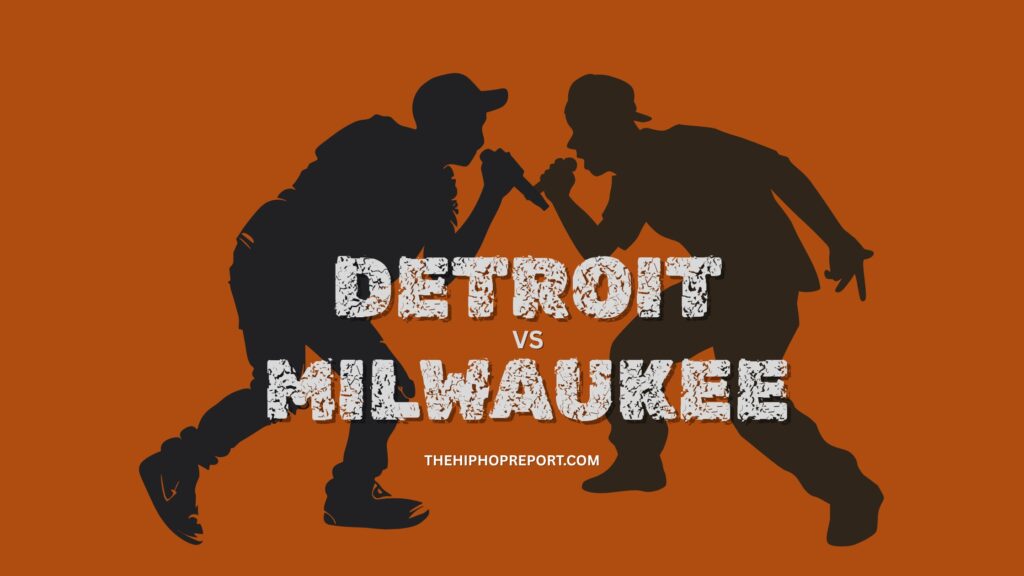Byline: The HipHop Report Staff
Date: July 5, 2025
Detroit and Milwaukee: Two Cities, Distinct Hip-Hop Legacies*
As the hip-hop landscape continues to evolve, regional rivalries and stylistic debates often come to the forefront. Recently, tensions erupted between Detroit and Milwaukee artists over claims of influence, originality, and cultural authenticity. To better understand this ongoing discourse, it is essential to examine the historical roots and cultural developments of both cities’ hip-hop scenes.
Detroit: The Blueprint of Street Credibility and Luxe Culture
Detroit’s hip-hop scene emerged in the late 1980s and early 1990s, rooted deeply in the city’s urban struggles, industrial history, and resilient community. Pioneering artists like Eminem, D-12, and Insane Clown Posse brought Detroit to the national stage, but it was the city’s gritty, street-oriented rap that defined its identity.
Detroit’s sound is characterized by raw storytelling, intense lyricism, and a hustler mentality. Artists such as T Grizzley, Peezy, Kash Doll, and Babyface Ray have continued this tradition, emphasizing themes of street hustle, survival, and authenticity. The influence of jewelry and luxury symbols, notably “Cartier swag,” became emblematic of success within Detroit’s rap culture, symbolizing wealth and street credibility.
This style has historically shaped the broader Midwest hip-hop scene and contributed significantly to the national narrative of authentic, street-rooted rap. Detroit’s music is often marked by dark, bass-heavy beats and narratives that reflect the city’s socio-economic realities.
Milwaukee: The Rise of Viral Dance Rap and Social Media Culture
In contrast, Milwaukee’s hip-hop scene gained prominence more recently, primarily in the 2000s and beyond. While the city’s musical roots include soul, jazz, and R&B, it was not until the past few years that Milwaukee’s rap scene gained widespread attention through social media and viral trends.
The Controversial Video Comparison
Artists like JP, Lil Chicken, Myaa P, and Destinee Lynn have pioneered a dance-oriented style that emphasizes catchy hooks, energetic beats, and viral dance moves. Tracks like Myaa P’s “Fairy” and the viral dance challenge “Uptown Downtown” by Steve The Stoner exemplify this trend. Milwaukee’s artists often incorporate playful personas and dance moves, sometimes twerking or adopting humorous gestures, reflecting a new culture of social media virality.
This approach has led Milwaukee to the forefront of viral rap, with mainstream celebrities such as Chris Brown and Kai Cenat engaging with the city’s dance trends. While still emerging, Milwaukee’s style is being recognized as a fresh, innovative wave—distinct from traditional street rap but equally influential in the digital age.
A Tale of Two Styles: Roots and Evolution
The debate over who “had it first”—whether Milwaukee’s dance-driven rap or Detroit’s street authenticity—is rooted in the cities’ contrasting histories. Detroit’s influence on street credibility, jewelry culture, and gritty storytelling is well-established and historically significant. Its artists have long set the tone for authentic urban rap, with a legacy built on resilience and raw expression.
Milwaukee’s current viral success, however, represents an evolution driven by social media’s power to rapidly popularize catchy, danceable content. While Milwaukee’s dance style is relatively new, it is reshaping perceptions of regional hip-hop, blending humor, energy, and social media savvy.
Conclusion
Both Detroit and Milwaukee have made indelible marks on hip-hop’s cultural tapestry. Detroit’s influence is rooted in decades of authentic, street-oriented storytelling, laying a foundation that continues to inspire. Milwaukee’s rise as a viral dance hub signals the genre’s adaptability and the power of social media to redefine regional identities.
Ultimately, the ongoing rivalry highlights the dynamic nature of hip-hop—where history, innovation, and regional pride collide, fueling the genre’s growth and diversity. As both cities continue to evolve, their unique contributions affirm hip-hop’s status as a reflection of varied cultural landscapes across America.


More Stories
PRE$HA3X: Destinee Lynn, Bri Biase & Asianae Just Lit a Fire Under Female Rap — And It’s Spreading Fast
ATL’S FEMALE RAP TRIFECTA JUST WENT NUCLEAR ON THE “WHAM CHALLENGE” 🔥